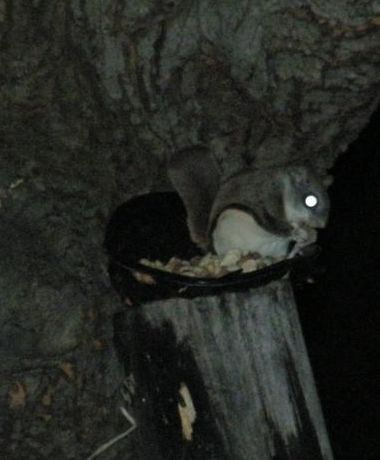 Who is this bright-eyed visitor at Marcy Cunkelman’s feeder in Indiana County?
Who is this bright-eyed visitor at Marcy Cunkelman’s feeder in Indiana County?
For starters he is very, very cute. With large, beautiful eyes he is so small you can hold him in the cup of your hand. He has soft gray-brown fur on his back and a white belly. His body is flattened and he has a fold of skin from his wrists to his ankles. Even his tail is flat so he can steer effectively.
He’s nocturnal, shy and gentle unlike his distant cousins who damaged my bird feeder. And finally, his Latin name Glaucomys volans means “graymouse flying.”
By now I’m sure you’ve guessed he’s a flying squirrel. I’ve done some guessing too – that he’s a southern, as opposed to northern, flying squirrel – based on their relative abundance in Indiana County (fewer northerns) and the type of forest near Marcy’s house (the kind southerns prefer). To really identify this guy I must see his size and color, neither of which I can tell from this picture.
Flying squirrels live in mature forests with abundant oaks, hickories and beeches. Their main foods are nuts and fruits. Like all squirrels they store food for the winter and can hardly wait for spring. Soon they’ll be munching on tree buds – a favorite delicacy – as well as blossoms, mushrooms, eggs, nestlings (oh no!) and even maple sap. They are so omnivorous they’ll even eat carrion.
Their principle means of travel is by gliding from tree to tree – almost, but not quite, flying. They climb high, bob their heads to judge distance and take off. Sailing with arms and legs outstretched they look like kites, then land back feet first on the target tree. Click here to see a video of this action.
Flying squirrels nest in tree cavities that they line with shredded bark, leaves and grass. They normally have several nests located in abandoned woodpecker holes: a primary nest that they use the most and others that are havens when the first one is threatened. The nests must have small entrance holes 1.6″ to 2″ in diameter or else gray squirrels take them over.
This month and next the flying squirrels will produce their first of two annual litters containing three or four young. Their newborns are hairless and helpless with closed eyes and ears. In seven weeks they reach adult size and are weaned. By the Fourth of July Marcy will have several more flying squirrels in her area and perhaps at her feeder.
I have never seen a flying squirrel – my city neighborhood doesn’t have the right habitat – but it pays to watch your feeders at dusk. Maybe you’ll have a night visitor.
(photo by Marcy Cunkelman)
My dad, who lived in South Carolina at the time, caught two flying squirrels with a Havahart trap. He knew something was living in his attic and the next morning we were all surprised (squirrels included) at what was in the trap. They are very cute.
A few years ago a poor flying squirrel managed to find his (her?) way into the cloister of my building (Frick Fine Arts, Pitt). The poor thing was thoroughly traumatized, but it was really neat to finally see one. Once he finally calmed down and just curled into a trembling ball, we managed to scoop him into a box and release him outside.
That must mean there are flying squirrels in Schenley Park. Wow! Thanks for letting me know.